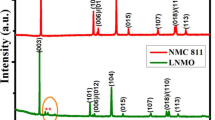Abstract
Gas evolution has a profound effect on the functioning of state-of-the-art lithium-ion batteries. On one hand, it is the natural concomitant of solid electrolyte interphase (SEI) formation on the anode (reduction of electrolyte components). On the other hand, because of the demand for high terminal voltages, it is also the consequence of electrolyte and/or cathode material oxidation. Overall, gassing happens on the expense of Coulombic efficiency and additionally raises safety issues. Herein, the gassing behavior of one of the most important commercialized cathode materials, namely Ni-rich Li1 + x Ni0.5Co0.2Mn0.3O2 (NCM523 with 0.01 < x < 0.05), is reported for the first time. We analyze the generation pattern of the most typical gases H2, C2H4, CO2, and CO during 30 cycles by means of differential electrochemical mass spectrometry combined with Fourier transform infrared spectroscopy. In a long-term test of an NCM523/graphite cell, we monitor its potential-resolved gas evolution and evaluate the total amount of gas from cycle to cycle. An explanation on the characteristic features of pressure versus time curves during cycling is given by combining the spectrometric and total gas pressure data. With additional information from graphite/lithium cells, the identity of gases formed during SEI formation is revealed.







Similar content being viewed by others
References
Ohzuku T, Brodd RJ (2007) An overview of positive-electrode materials for advanced lithium-ion batteries. J Power Sources 174:449–456
Nitta N, Wu F, Lee JT, Yushin G (2015) Li-ion battery materials: present and future. Mater Today 18:252–264
Berkes BB, Jozwiuk A, Sommer H, Brezesinski T, Janek J (2015) Simultaneous acquisition of differential electrochemical mass spectrometry and infrared spectroscopy data for in situ characterization of gas evolution reactions in lithium-ion batteries. Electrochem Commun 60:64–69
Michalak B, Berkes BB, Sommer H, Bergfeldt T, Brezesinski T, Janek J (2016) Gas evolution in LiNi0.5Mn1.5O4/graphite cells studied in operando by a combination of differential electrochemical mass spectrometry, neutron imaging, and pressure measurements. Anal Chem 88:2877–2883
Wang H, Rus E, Sakuraba T, Kikuchi J, Kiya Y, Abruña HD (2014) CO2 and O2 evolution at high voltage cathode materials of Li-ion batteries: a differential electrochemical mass spectrometry study. Anal Chem 86:6197–6201
Metzger M, Marino C, Sicklinger J, Haering D, Gasteiger HA (2015) Anodic oxidation of conductive carbon and ethylene carbonate in high-voltage Li-ion batteries quantified by on-line electrochemical mass spectrometry. J Electrochem Soc 162:A1123–A1134
Ota H, Sakata Y, Inoue A, Yamaguchi S (2004) Analysis of vinylene carbonate derived SEI layers on graphite anode. J Electrochem Soc 151:A1659–A1669
Bernhard R, Meini S, Gasteiger HA (2014) On-line electrochemical mass spectrometry investigations on the gassing behavior of Li4Ti5O12 electrodes and its origins. J Electrochem Soc 161:A497–A505
Kumai K, Miyashiro H, Kobayashi Y, Takei K, Ishikawa R (1999) Gas generation mechanism due to electrolyte decomposition in commercial lithium-ion cell. J Power Sources 81–82:715–719
Lanz P, Sommer H, Schulz-Dobrick M, Novák P (2013) Oxygen release from high-energy xLi2MnO3·(1 − x)LiMO2 (M = Mn, Ni, Co): electrochemical, differential electrochemical mass spectrometric, in situ pressure, and in situ temperature characterization. Electrochim Acta 93:114–119
Onuki M, Kinoshita S, Sakata Y, Yanagidate M, Otake Y, Ue M, Deguchi M (2008) Identification of the source of evolved gas in Li-ion batteries using 13C-labeled solvents. J Electrochem Soc 155:A794–A797
He Y-B, Li B, Liu M, Zhang C, Lv W, Yang C, Li J, Du H, Zhang B, Yang Q-H, Kim J-K, Kang F (2012) Gassing in Li4Ti5O12-based batteries and its remedy. Scientific Reports 2:913
Berkes BB, Jozwiuk A, Vračar M, Sommer H, Brezesinski T, Janek J (2015) On-line continuous flow differential electrochemical mass spectrometry with a realistic battery setup for high-precision, long-term cycling tests. Anal Chem 87:5878–5883
Marom R, Haik O, Aurbach D, Halalay IC (2010) Revisiting LiClO4 as an electrolyte for rechargeable lithium-ion batteries. J Electrochem Soc 157:A972–A983
Xing L, Borodin O (2012) Oxidation induced decomposition of ethylene carbonate from DFT calculations—importance of explicitly treating surrounding solvent. Phys Chem Chem Phys 14:12838–12843
Chusid O, Ein Ely E, Aurbach D, Babai M, Carmeli Y (1993) Electrochemical and spectroscopic studies of carbon electrodes in lithium battery electrolyte systems. J Power Sources 43:47–64
Jozwiuk A, Berkes BB, Weiß T, Sommer H, Janek J, Brezesinski T (2016) The critical role of lithium nitrate in the gas evolution of lithium–sulfur batteries. Energy Environ Sci 9:2603–2608
Aurbach D, Ein-Eli Y, Markovsky B, Zaban A, Luski S, Carmeli Y, Yamin H (1995) The study of electrolyte solutions based on ethylene and diethyl carbonates for rechargeable Li batteries: II. Graphite Electrodes J Electrochem Soc 142:2882–2890
Edström K, Andersson AM, Bishop A, Fransson L, Lindgren J, Hussénius A (2001) Carbon electrode morphology and thermal stability of the passivation layer. J Power Sources 97–98:87–91
Aurbach D, Ein-Eli Y, Chusid O, Carmeli Y, Babai M, Yamin H (1994) The correlation between the surface chemistry and the performance of Li-carbon intercalation anodes for rechargeable ‘rocking-chair’ type batteries. J Electrochem Soc 141:603–611
Chiang P-CJ WM-S, Lin J-C (2005) A novel dual-current formation process for advanced lithium-ion batteries. Electrochem Solid-State Lett 8:A423–A427
Lee H-H, Wang Y-Y, Wan C-C, Yang M-H, Wu H-C, Shieh D-T (2004) A fast formation process for lithium batteries. J Power Sources 134:118–123
Campion CL, Li W, Lucht BL (2005) Thermal decomposition of LiPF6-based electrolytes for lithium-ion batteries. J Electrochem Soc 152:A2327–A2334
Acknowledgments
This study is part of projects being funded within the BASF International Network for Batteries and Electrochemistry.
Author information
Authors and Affiliations
Corresponding author
Electronic supplementary material
ESM 1
(DOCX 1347 kb)
Rights and permissions
About this article
Cite this article
Berkes, B.B., Schiele, A., Sommer, H. et al. On the gassing behavior of lithium-ion batteries with NCM523 cathodes. J Solid State Electrochem 20, 2961–2967 (2016). https://doi.org/10.1007/s10008-016-3362-9
Received:
Revised:
Accepted:
Published:
Issue Date:
DOI: https://doi.org/10.1007/s10008-016-3362-9




